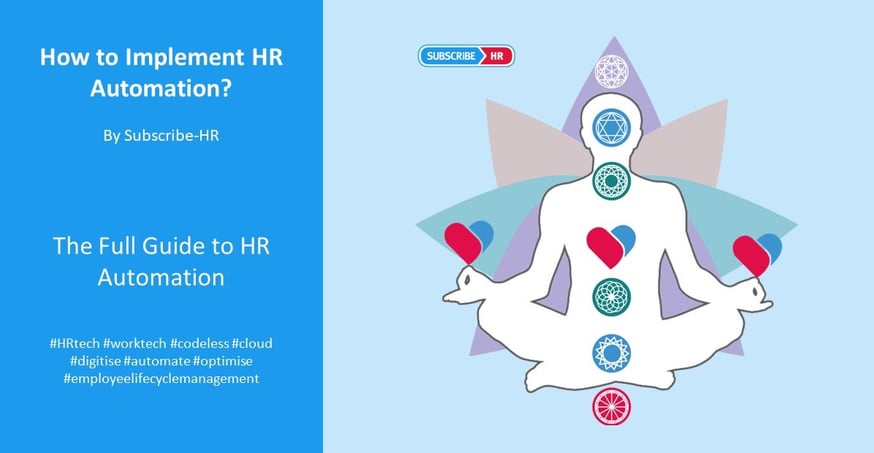Even with all the productivity-aiding technologies available to us today, HR managers still lose 14 hours per week on tasks that could be automated.
What would your team do with those fourteen extra hours? You’d have that extra time to spend on strategic initiatives and growing the business.
But automating your HR processes can be daunting – it’s difficult to know where to start and what to automate first.
In this in-depth guide, we’ll be walking you through exactly how your organisation can benefit from HR automation. ⬇️

How HR Automation is Changing Organisations’ Futures
Over the past few years, automation has reshaped industries across the globe, allowing businesses to exponentially grow. HR automation has completely redefined the way organisations approach their people management.
Streamlining workflows and reducing burnout
One of the most significant impacts of HR automation is the streamlining of HR workflows. In traditional HR processes, numerous tasks are manual, repetitive, and time-consuming. These tasks often burden HR professionals and consume valuable time that could be better spent on strategic HR initiatives.
With the integration of automation, many of these tasks can be seamlessly streamlined. From managing payroll to handling the onboarding and offboarding of employees, and even overseeing performance management, automation software can tackle these essential functions with efficiency and precision.
This is especially crucial since small and large organisations alike face the challenge of limited HR resources. Many HR teams are overburdened with responsibilities, leading to burnout, particularly for HR managers. Automating repetitive processes alleviates this burden, allowing HR professionals to focus on high-value, strategic tasks.

Saving costs
HR automation saves costs for organisations through various means. When you are able to automate routine administrative tasks like data entry and paperwork processing, you can reduce the need for extensive administrative staff, resulting in direct cost savings. Automation also enhances efficiency and productivity, allowing HR professionals to handle a larger workload without additional hires.
Furthermore, it significantly reduces the likelihood of errors in HR processes, minimising the costs associated with error resolution and legal liabilities. HR automation systems include compliance features, reducing the risk of costly non-compliance fines and legal actions. 👍
Implementing HR Automation Step by Step
Step 1: Identifying the right tasks for HR automation
Before you start automating your HR processes, it’s really important to take a look at your overall tasks and see which are appropriate for automation.
It’s a good strategy to start with the tasks that are most time-consuming and require a lot of manual input. Some examples are:
- Onboarding and offboarding document collection, form filling, access provisioning
- Exit interviews
- Payroll calculations, tax deductions, and direct deposit transfers
- Job postings, resume screening, candidate communication, and interview scheduling
- Employee engagement surveys
- Employee goal setting and tracking
Step 2: Setting the right goals
HR automation is powerful, but it isn’t a magic solution for all HR problems. That’s why it’s really important to set the right goals before implementing automation – so that you can achieve realistic goals.
Some goals you could be seeking to achieve with HR automation include 👇
- Reducing the time required for HR tasks and processes
- Increasing the throughput of HR operations, such as onboarding and offboarding
- Decreasing administrative and operational HR costs
- Lowering expenses related to recruitment, training, and payroll processing
- Minimising data entry errors, payroll inaccuracies, and compliance-related mistakes
- Improving data accuracy and reducing error-related costs
- Ensuring HR processes consistently adhere to labour laws and regulations
- Maintaining high levels of data accuracy in HR records
- Reducing the time employees spend on administrative tasks
- Improving self-service capabilities for employees
- Streamlining and enhancing the onboarding and offboarding experiences
- Reducing the time it takes to fill job vacancies
- Improving the quality of candidates
- Decreasing the cost per hire
- Tracking and improving employee performance and goal achievement
- Aligning individual employee goals with organisational objectives
- Improving the quality of HR data
- Developing insightful analytics
- Making data-driven decisions to enhance HR strategies
- Increasing employee participation in engagement surveys
- Improving feedback mechanisms and action plans based on survey results
- Enhancing reporting capabilities, including custom reports, visual dashboards, and trend analysis
- Maintaining robust data security and data privacy measures to protect sensitive employee data
- Measuring and maintaining high user satisfaction levels with HR automation tools
- Reducing paper and printing costs to minimise the environmental footprint by promoting a paperless HR environment
- Developing and tracking key HR metrics and performance indicators to assess the impact of automation on HR processes
- Improving talent retention rates by enhancing employee experiences and professional development opportunities
- Setting goals to expedite the recruitment process and reduce the time it takes to fill open positions
- Encouraging higher adoption of self-service HR tools among employees for routine inquiries and requests
- Ensuring that payroll is processed accurately and on time, reducing errors and delays

💡 Quick tip: When setting HR automation goals, ensure they are Specific, Measurable, Achievable, Relevant, and Time-bound (SMART). This framework helps create clear and actionable objectives that can be tracked and evaluated effectively. 👍
Step 3: Choose the right HR automation tools
Going with the right HR automation tools can make or break your organisation’s HR success… Which is why it’s super important to shop around and know what you’re looking for. ⬇️
Factors to consider when choosing HR automation tools
First things first, there are a few crucial factors to consider. 👇
Scalability and integrations
- Ensuring the tools can scale with your organisation's growth and evolving HR needs
- Verifying that the HR automation tools can seamlessly integrate with your existing software systems to prevent data silos
Usability and customisation
- Choose tools with user-friendly interfaces to ensure easy adoption by your HR team
- Look for tools that offer customisation options to tailor automation processes to match your unique workflows
- Consider how data migration from existing systems will be handled during implementation
Security and support
- Ensure the tools meet data security and compliance standards, especially for sensitive employee data
- Assess the availability of training resources and customer support for successful implementation and ongoing assistance
Cost and evaluation
- Evaluate the total cost of ownership, including licensing, implementation, and maintenance costs, in comparison to the expected ROI
- Gather input from potential users within your organisation to understand their preferences, concerns, and requirements
- Research the reputation and track record of the vendors providing the HR automation tools
Pilot-testing and future-proofing
- Consider piloting the selected tool with a smaller group or department before full-scale implementation
- Ensure the tools are adaptable to future changes and advancements in HR technology
Legal and compliance
- Review contracts, service-level agreements, and terms and conditions carefully to understand licensing, support, and data ownership terms
- Ensure the tools can assist in maintaining HR compliance with labour laws and regulations
User experience and feedback
- Pay attention to the overall user experience, including ease of use, navigation, and accessibility
- Assess the tools' capabilities for gathering feedback from users to facilitate continuous improvement
- Evaluate the ease of adoption for HR professionals and the availability of training resources

Mobile accessibility and data analytics
- Consider whether the tools are accessible on mobile devices, as mobile HR access is increasingly important
- Evaluate the tools' capabilities for data analytics and reporting to generate insights for decision-making
Workflow automation and sustainability
- Assess the extent to which the tools can automate complex HR workflows and processes
- Ensure the tools provide role-based user permissions and robust security features to protect sensitive HR data
- Consider how the tools can contribute to environmental sustainability, such as reducing paper usage
Step 4: Check the HR automation tool’s integrations
➡️ Once you’ve checked your potential HR automation tool against all the above important factors, you’ll be able to get a clear idea of how well it performs.
It’s also a good idea to check out the tool’s list of integrations. Ultimately, the more integrations, the better. For example, here at SubscribeHR, our HR automation tool integrates with the following:
- Microsoft Dynamics
- Oracle + Netsuite
- Dialog Dynamics
- CouncilFirst
- JCurve ERP
- Xero
- myob
- easyemployer
- InfinetCloud
- Aussiepay
- Attache
- Data Pay
- deputy
- iPayroll
- CloudPayroll
- ADP Payroll
- KeyPay
- Skedulo
- MicrOpay
- 2cloudnine
- Pirkx
- Seek
- I Work For NSW
- Indeed
- trademe
- Adzuna
- EthicalJobs
- GO1
- Moodle
- Yammer
- Onelogin
- CV Check
- Orgchart
- Salesforce Appexchange
- 2Cloud9
- AWS
If you’re able to find an HR automation tool with plenty of integrations, you can then seamlessly connect with other software systems used across your organisation. This streamlines workflows and reduces the need for manual data entry and data transfer between systems. 👍
Step 5: The HR automation tool pilot test
By now, you should have a pretty clear idea of which HR automation tool you want to use. The next step is to implement a pilot test so that you can minimise risk, engage stakeholders, and collect feedback for the tool.
Ultimately, the aim here is to check if it really is a good idea to roll out the HR automation tool organisation-wide. Let’s break down the steps to do so ⬇️
- Choose a small, representative group of HR professionals and end-users who will participate in the pilot. Ensure they reflect the diversity of roles and responsibilities within the organisation
- Set specific, measurable objectives for the pilot
- Configure the HR automation tool to match your organisation's unique workflows. This ensures that the tool aligns with your processes during the pilot
- Provide comprehensive training to the selected participants. Ensure they understand how to use the tool effectively and encourage them to explore its features
- Establish a feedback mechanism that allows pilot participants to report issues, suggest improvements, and share their experiences. Actively encourage them to provide input
- Continuously monitor the pilot test to ensure it's on track. Collect data on the tool's performance and its impact on HR processes
- Analyse the data collected during the pilot to assess the tool's performance against your predefined objectives
- Document the lessons learned during the pilot. What worked well, what needs improvement, and what surprised you?
- Use the feedback and data gathered to fine-tune the tool, addressing any issues or areas for improvement
So, what’s the verdict? How did the tool perform? 👀

Step 6: Migrating your data to the HR tool
Now that you’ve officially settled on an HR automation tool, it’s time to migrate your organisation’s data. Migrating data to a new tool is a meticulous process that, when done right, ensures that everything is in its place and ready for action. 👍
What is data migration?
Data migration is the process of transferring data from one system to another. In the context of HR, it's about moving essential employee information, historical records, and HR-related data to your new HR automation tool.
Here’s how to approach data migration to your new HR automation tool ⬇️
Assessment and preparation
- Start by assessing the data you need to migrate. Identify what data is critical, what can be archived or deleted, and what data can be left in the old system
- Clean and organise your data. Remove duplicates, outdated records, and any irrelevant information
- Ensure that the data in the source system is accurate and up-to-date
Data mapping
- Map out the fields in your old system to the equivalent fields in your new HR tool. This is a critical step to ensure data is placed in the right locations
🔍 Some data mapping tools that will be useful at this step are Altova MapForce or Skyvia.
Backup
- Before migrating the data, take a backup of both the old system and the new HR tool to ensure data can be restored in case of unexpected issues
Data extraction
- Use appropriate data extraction tools or scripts to export data from your old system. Ensure that you maintain data integrity during the extraction process
🔍 You could use tools like Integrate.io, Airbyte, Fivetran, Hevo Data etc.
Data transformation
- If the data format in your old system is different from your new HR tool, you may need to transform it to match the required format. Do this before you load the data
Data loading
- Import the transformed data into your new HR tool. Make sure the data is accurately and securely transferred
Data validation
- Verify the data in the new HR tool to ensure it matches the source data. Check for any discrepancies or missing information
Testing
- Conduct extensive testing to validate that the data behaves as expected in the new HR tool
- Test data across various scenarios and processes

Step 7: Customising and configuring your HR automation tool
HR automation tools that fit your organisation like a glove are incredibly powerful. That’s why customising and configuring your tool isn’t a step you’ll want to skip. ✨
First of all, before you even start customising anything, make sure you have a thorough map-out of your existing HR processes so that you know what needs customisation.
- Determine who needs access to what parts of the HR automation tool. Define user roles and permissions to control data access and ensure data security
- Customise data fields and forms to match your organisation's terminology and data requirements. Add or remove fields as needed for your specific processes
- Set up automated workflows for common HR processes like onboarding, offboarding, and performance management. Define the sequence of tasks and approvals
- Configure notifications and alerts to keep HR professionals and employees informed of key events, such as new hire onboarding or performance reviews
- Ensure that your HR automation tool seamlessly integrates with other software systems used in your organisation. This ensures data consistency and avoids data silos
- Customise data import and export processes to match your data format and requirements. Ensure that data can flow in and out of the tool smoothly
- Customise reporting and analytics dashboards to track key HR metrics and KPIs. Tailor reports to meet your organisation's reporting needs
Step 8: Training and user adoption
It goes without saying that training and ensuring user adoption are pivotal steps in maximising the benefits of your HR automation tool.
Proper training empowers your HR professionals to use the tool efficiently, streamlining HR processes and reducing manual workloads – users who are familiar with the tool can take full advantage of its features and capabilities 👍
But how do you adequately train your team to ensure user adoption of the HR automation tool? Let’s find out ⬇️
Tailored training programs
- Develop training programs that cater to different user groups within your organisation
- Conduct interactive, hands-on training sessions that allow users to navigate the tool and practice tasks in a safe environment
- Ensure that new hires receive comprehensive training on the HR automation tool as part of their onboarding process
- Create video tutorials that walk users through common tasks and processes. Visual content can be a valuable training resource
- Offer regular workshops or webinars to refresh users' knowledge and keep them informed about updates and new features
- Introduce gamified elements into training to make learning more engaging. Challenges, quizzes, and rewards can motivate users
User manuals and documentation
- Provide user-friendly manuals and documentation that users can reference for step-by-step instructions and troubleshooting
- Utilise online learning platforms or Learning Management Systems (LMS) to deliver and track training progress
- Establish a user support system, such as a dedicated support team or a helpdesk, where users can seek assistance and resolve issues
Feedback
- Create a feedback mechanism where users can report issues, provide input, and suggest improvements to the tool
- Continuously measure and evaluate the effectiveness of your training and user adoption efforts. Make improvements based on feedback and outcomes
- Act on user feedback by implementing relevant changes or customizations to enhance the user experience

Step 9: Ensuring data security and compliance
Data security and compliance are not optional; they are essential. You’ll want to be able to ensure confidentiality for users’ private information, adhere to relevant legal requirements, and maintain data integrity. 👍
Compliance framework
- Start by creating a compliance framework that outlines the steps needed to meet the regulatory requirements.
- This can include creating policies, procedures, and controls
- Establish a mechanism for obtaining explicit consent from employees for data processing, as required by regulations
Data classification
- Classify HR data based on its sensitivity, ensuring that higher-risk data receives greater protection
Access control
- Implement robust access control measures, including role-based permissions, to restrict data access to authorised individuals only
Data encryption
- Employ data encryption techniques to protect data both in transit and at rest within the HR automation tool
Regular auditing
- Conduct regular audits to monitor data access, changes, and ensure compliance with your framework
Incident response plan
- Develop an incident response plan to address data breaches or privacy violations promptly and effectively

Data retention policies
- Define data retention policies to ensure that data is not kept longer than necessary
Employee training
- Provide training to employees and HR professionals on data security, privacy policies, and compliance requirements
- Provide clear and concise data privacy notices to employees, informing them about data collection, storage, and usage
- Ensure that employees have the ability to access and export their data as required by certain data protection laws.
Regular updates
- Keep your HR automation tool and security measures up to date to address evolving security threats and compliance changes
- Regularly review and enhance your data security and compliance efforts to stay aligned with the changing regulatory landscape
Documentation
- Maintain detailed records of data protection and compliance efforts, including policies, training records, and audits
Takeaway
👆 Hopefully by now you will have gained an understanding of all the steps involved in properly implementing an HR automation tool.
HR automation is not just about technology though; it's a mindset shift. Embrace change and the opportunities it presents for streamlining processes, reducing manual workloads, and making data-driven decisions 🚀
Here is a recap of what to consider when automating your HR processes:
- Before selecting an HR automation tool, define your objectives and align them with the specific processes and tasks that need automation. Setting clear goals ensures that the tool serves your unique needs
- Successful implementation hinges on user adoption. Invest in training and support to empower HR professionals and employees to use the tool effectively
- Rigorous testing and quality assurance are vital to ensure that the tool operates seamlessly, adheres to data security and compliance requirements, and delivers a positive user experience
- Protecting sensitive employee data and complying with privacy regulations are non-negotiable
- The journey doesn't end with implementation. Continuously evaluate, improve, and adapt your HR automation tool to meet evolving organisational needs and stay ahead of industry changes
💡 Got any questions? We’ll answer them! Contact us here at SubscribeHR using the form below and we’ll help you with all things HR automation ✨

